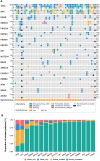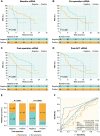Dynamic monitoring of circulating tumor DNA to predict prognosis and efficacy of adjuvant chemotherapy after resection of colorectal liver metastases
- PMID: 34093868
- PMCID: PMC8171084
- DOI: 10.7150/thno.59644
Dynamic monitoring of circulating tumor DNA to predict prognosis and efficacy of adjuvant chemotherapy after resection of colorectal liver metastases
Abstract
Rationale: Hepatectomy and adjuvant chemotherapy after resection of colorectal liver metastases (CRLM) may improve survival, however, patients which may benefit cannot currently be identified. Postoperative circulating tumor DNA (ctDNA) analysis can detect minimal residual disease (MRD) and predict the prognosis and efficacy of adjuvant chemotherapy. Our study aims to determine the impact of serial ctDNA analysis to predict the outcome among patients undergoing resection of CRLM. Methods: Between May 2018 and October 2019, 91 CRLM patients were prospectively enrolled. Whole exome sequencing was performed in 50 primary and 48 metastatic liver tissues. Targeted sequencing of 451 cancer relevant genes was performed in 50 baseline plasma to determine plasma-tissue concordance. We prospectively investigated changes in the amount and constitution of ctDNA in 271 serial plasma samples taken at different time points (baseline, pre-operation, post-operation, post-operative adjuvant chemotherapy (post-ACT) and recurrence) during the treatment of CRLM. Results: Detected molecular alterations were highly consistent among baseline ctDNA, primary and liver metastases tissue. Patients with a higher variant allele frequency (VAF) level at baseline ctDNA represent a higher tumor burden, and decreased ctDNA during pre-operative chemotherapy predicted better tumor response. Patients with detectable post-operative and post-ACT ctDNA were associated with significantly shorter recurrence-free survival (RFS). ROC analysis showed that post-ACT ctDNA status was superior to post-operative ctDNA status in predicting RFS with an AUROC of 0.79. A significant difference in overall recurrence rate was observed in patients with detectable vs undetectable levels of ctDNA after resection of CRLM (79.4% vs 41.7%) and after completion of adjuvant chemotherapy (77.3% vs 40.7%). During adjuvant chemotherapy, patients with decreased ctDNA VAF after adjuvant chemotherapy had a recurrence rate of 63.6%, compared to 92.3% in patients with increased ctDNA VAF. Conclusions: We envision that dynamic ctDNA analysis, especially in a post-ACT setting, might be used to not only reflect MRD but also to determine rational personalized adjuvant therapy after the resection of CRLM.
Keywords: adjuvant chemotherapy; colorectal liver metastases; ctDNA; next-generation sequencing; prognosis.
© The author(s).
Conflict of interest statement
Competing Interests: The authors have declared that no competing interest exists.
Figures




Similar articles
-
Circulating tumor DNA dynamics and recurrence risk in patients undergoing curative intent resection of colorectal cancer liver metastases: A prospective cohort study.PLoS Med. 2021 May 3;18(5):e1003620. doi: 10.1371/journal.pmed.1003620. eCollection 2021 May. PLoS Med. 2021. PMID: 33939694 Free PMC article.
-
Pre-hepatectomy dynamic circulating tumor DNA to predict pathologic response to preoperative chemotherapy and post-hepatectomy recurrence in patients with colorectal liver metastases.Hepatol Int. 2024 Jun;18(3):1029-1039. doi: 10.1007/s12072-023-10628-4. Epub 2024 Mar 1. Hepatol Int. 2024. PMID: 38427145
-
Comparing baseline VAF in circulating tumor DNA and tumor tissues predicting prognosis of patients with colorectal cancer liver metastases after curative resection.Clin Res Hepatol Gastroenterol. 2024 Nov;48(9):102464. doi: 10.1016/j.clinre.2024.102464. Epub 2024 Sep 12. Clin Res Hepatol Gastroenterol. 2024. PMID: 39276854
-
Circulating Tumor DNA as a Real-Time Biomarker for Minimal Residual Disease and Recurrence Prediction in Stage II Colorectal Cancer: A Systematic Review and Meta-Analysis.Int J Mol Sci. 2025 Mar 11;26(6):2486. doi: 10.3390/ijms26062486. Int J Mol Sci. 2025. PMID: 40141130 Free PMC article.
-
Minimal residual disease in colorectal cancer. Tumor-informed versus tumor-agnostic approaches: unraveling the optimal strategy.Ann Oncol. 2025 Mar;36(3):263-276. doi: 10.1016/j.annonc.2024.12.006. Epub 2024 Dec 13. Ann Oncol. 2025. PMID: 39675560 Review.
Cited by
-
Cell-free DNA in the management of prostate cancer: Current status and future prospective.Asian J Urol. 2023 Jul;10(3):298-316. doi: 10.1016/j.ajur.2022.11.002. Epub 2022 Dec 9. Asian J Urol. 2023. PMID: 37538150 Free PMC article. Review.
-
Clinical application of molecular residual disease detection by circulation tumor DNA in solid cancers and a comparison of technologies: review article.Cancer Biol Ther. 2023 Dec 31;24(1):2274123. doi: 10.1080/15384047.2023.2274123. Epub 2023 Nov 13. Cancer Biol Ther. 2023. PMID: 37955635 Free PMC article. Review.
-
Circulating tumor DNA in colorectal cancer: biology, methods and applications.Discov Oncol. 2025 Apr 1;16(1):439. doi: 10.1007/s12672-025-02220-z. Discov Oncol. 2025. PMID: 40167831 Free PMC article. Review.
-
Methylated ctDNA predicts early recurrence risk in patients undergoing resection of initially unresectable colorectal cancer liver metastases.Ther Adv Med Oncol. 2024 Feb 28;16:17588359241230752. doi: 10.1177/17588359241230752. eCollection 2024. Ther Adv Med Oncol. 2024. PMID: 38425989 Free PMC article.
-
Efficacy and safety of totally laparoscopic gastrectomy with uncut Roux-en-Y for gastric cancer: a dual-center retrospective study.World J Surg Oncol. 2023 Sep 13;21(1):289. doi: 10.1186/s12957-023-03154-y. World J Surg Oncol. 2023. PMID: 37700312 Free PMC article.
References
-
- Amikura K, Akagi K, Ogura T, Takahashi A, Sakamoto H. The RAS mutation status predicts survival in patients undergoing hepatic resection for colorectal liver metastases: The results from a genetic analysis of all-RAS. J Surg Oncol. 2018;117:745–55. - PubMed
-
- Shindoh J, Nishioka Y, Yoshioka R, Sugawara T, Sakamoto Y, Hasegawa K. et al. KRAS Mutation Status Predicts Site-Specific Recurrence and Survival After Resection of Colorectal Liver Metastases Irrespective of Location of the Primary Lesion. Ann Surg Oncol. 2016;23:1890–6. - PubMed
Publication types
MeSH terms
Substances
LinkOut - more resources
Full Text Sources
Medical

